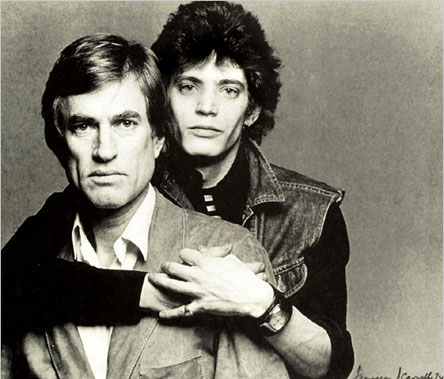

Partner Robert Mapplethorpe
Queer Places:
Yale University (Ivy League), 38 Hillhouse Ave, New Haven, CT 06520
Episcopal Church of the Heavenly Rest Manhattan, New York County (Manhattan), New York, USA
 Samuel
Jones Wagstaff, Jr. (November 4, 1921 – January 14, 1987) was an American art
curator and collector as well as the artistic mentor and benefactor of
photographer
Robert Mapplethorpe (who was also his lifetime companion) and poet-punk
rocker Patti Smith.
Wagstaff is known in part for his support of minimalism, pop art, conceptual
art and earthworks, but his aesthetic acceptance and support of photography
presaged the acceptance of the medium as a fine art.
Samuel
Jones Wagstaff, Jr. (November 4, 1921 – January 14, 1987) was an American art
curator and collector as well as the artistic mentor and benefactor of
photographer
Robert Mapplethorpe (who was also his lifetime companion) and poet-punk
rocker Patti Smith.
Wagstaff is known in part for his support of minimalism, pop art, conceptual
art and earthworks, but his aesthetic acceptance and support of photography
presaged the acceptance of the medium as a fine art.
Born on November 4, 1921, in New York City, Wagstaff was the son of Samuel Jones Wagstaff, Sr., a wealthy lawyer from an old Social Register family, and his second wife, Polish émigré Olga May Piorkowska, a fashion illustrator who had worked for Harper's Bazaar and was previously married to Arthur Paul Thomas.[1][2] He had one sibling, a sister, Judith (Mrs Thomas Lewis Jefferson). His parents divorced in 1932, and Wagstaff's mother, a daughter of Polish inventor and scientist Col. Arthur Emil Piorkowski, married Donald V. Newhall, an artist.
After growing up on Central Park South, attending the Hotchkiss School and graduating from Yale University, and being a fixture on the debutante circuit, Wagstaff joined the US Navy in 1941 as an ensign, where he took part in the D-day landing at Omaha Beach in World War II. He later worked in the field of advertising in the 1950s, which he hated. He returned to school to study Renaissance art at the New York University Institute of Fine Arts, however, and turned his energies to the art world.[3][4][5]
In 1959, a David E. Finley art history fellowship took him to the National Gallery of Art in Washington, DC. He served as curator of contemporary art at the Wadsworth Atheneum in Hartford, Connecticut from 1961 to 1968. In January, 1964, he organized the show "Black, White, and Gray," choosing exhibits presenting what he described as "the sparse aesthetic shared by a number of artists whose work was pared down to a minimum". It is now often referred to as the first survey of Minimalist Art.[6] In 1968, when he was not chosen for the position of museum director, Wagstaff left Hartford[7] for the Detroit Institute of Arts staying to 1971.[8] In addition to his curatorial work, Wagstaff was a noted collector, just like his father, who collected ephemera.[9] After a conflict with the Detroit Institute of Arts' board of trustees over an earthwork by Michael Heizer, which had destroyed the immaculate museum lawn, he moved back to New York.[4]
After seeing the exhibition "The Painterly Photograph, 1890-1914" at the Metropolitan Museum of Art in 1973 and meeting Robert Mapplethorpe in 1972, Wagstaff became convinced that photographs were the most unrecognized and, possibly, the most valuable works of art. He began selling his collection of paintings, using the proceeds to buy 19th-century American, British, and French photography. Then, influenced by Mapplethorpe, Wagstaff's taste veered toward the daring, and he began to depart from established names in search of new talent. His collection was soon recognized as one of the finest private holdings in the United States. In 1984 Wagstaff's photography collection went to the J. Paul Getty Museum, for a reported price said to be in the neighborhood of $5 million.[1][5]
Saying he needed the challenge of building another collection, Wagstaff turned to 19th-century American silver. A show of more than 100 examples from his silver collection opened on March 20, 1987 at the New-York Historical Society.[1]
Between 1976 and 1986, Wagstaff donated his personal papers to the Archives of American Art, Smithsonian Institution. In 2008, the bulk of these papers were digitized and made available online (see the Samuel J. Wagstaff Papers, 1932–1985).
Wagstaff met photographer Robert Mapplethorpe in 1972 at a party, beginning a fifteen-year relationship that would last until Wagstaff's death, described as "first a kind of marriage, sexual and artistic, then a friendship".[10] Mapplethorpe, whom Wagstaff called his shy pornographer, was also his guide to the gay demimonde of extreme sex and drugs that flourished in New York in the 1970s and 1980s.[3] In the autumn of 1972, Wagstaff gave Mapplethorpe $500,000 to purchase the top-floor loft at 24 Bond Street, where the photographer lived and had his shooting space.
Wagstaff died of pneumonia arising from AIDS at his home in Manhattan on January 14, 1987, two years before Mapplethorpe.[1][11]
Church of the Heavenly Rest
A fund in Wagstaff's name for the purchase of photographs was started in 1987 at the Metropolitan Museum of Art by art dealer Daniel Wolf.[1]
In 2007, James Crump directed the documentary film Black White + Gray, which premiered at the 2007 Tribeca Film Festival. In his New York Times review of the film, critic Stephen Holden wrote "Because Mapplethorpe's story is already familiar, the movie devotes most of its time to Wagstaff, whose personal history is a classic case of repressed or closeted homosexuality belatedly and furiously unleashed."[3]
In 2014, Wagstaff: Before and After Mapplethorpe, a biography of Wagstaff, by Philip Gefter, was published by Norton/Liveright, and won the 2014 Marfield Prize for Arts Writing.[12]
My published books: